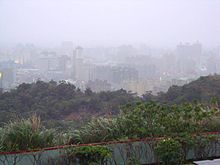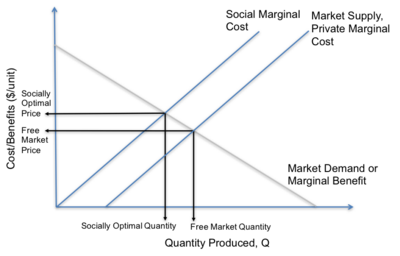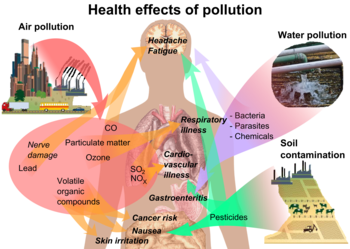pollution
the primary sources of pollution. The Industrial Revolution brought an infusion of untreated chemical
s and wastes into local streams that served as the water supply. King Edward I of England banned the burning of sea-coal by proclamation in London in 1272, after its smoke became a problem;[6][7] the fuel was so common in England that this earliest of names for it was acquired because it could be carted away from some shores by the wheelbarrow.
It was the industrial revolution that gave birth to environmental pollution as we know it today. London also recorded one of the earlier extreme cases of water quality problems with the Great Stink on the 1858, which led to construction of the London sewerage system soon afterward. Pollution issues escalated as population growth far exceeded viability of neighborhoods to handle their waste problem. Reformers began to demand sewer systems and clean water.[8]
In 1870, the sanitary conditions in Berlin were among the worst in Europe. a truly fearsome smell. There were no public toilets in the streets or squares. Visitors, especially women, often became desperate when nature called. In the public buildings the sanitary facilities were unbelievably primitive....As a metropolis, Berlin did not emerge from a state of barbarism into civilization until after 1870."[9]
The primitive conditions were intolerable for a world national capital, and the Imperial German government brought in its scientists, engineers, and urban planners to not only solve the deficiencies, but to forge Berlin as the world's model city. A British expert in 1906 concluded that Berlin represented "the most complete application of science, order and method of public life," adding "it is a marvel of civic administration, the most modern and most perfectly organized city that there is."[10]
The emergence of great factories and consumption of immense quantities of coal gave rise to unprecedented air pollution and the large volume of industrial chemical discharges added to the growing load of untreated human waste. Chicago and Cincinnati were the first two American cities to enact laws ensuring cleaner air in 1881. Pollution became a major issue in the United States in the early twentieth century, as progressive reformers took issue with air pollution caused by coal burning, water pollution caused by bad
Air pollution would continue to be a problem in England, especially later during the industrial revolution, and extending into the recent past with the Great Smog of 1952. Awareness of atmospheric pollution spread widely after World War II, with fears triggered by reports of radioactive fallout from atomic warfare and testing.[14] Then a non-nuclear event—the Great Smog of 1952 in London—killed at least 4000 people.[15] This prompted some of the first major modern environmental legislation: the Clean Air Act of 1956.
Pollution began to draw major public attention in the United States between the mid-and early , when Congress passed the Noise Control Act, the Clean Air Act, the Clean Water Act, and the National Environmental Policy Act.[16]
Severe incidents of pollution helped increase consciousness. PCB dumping in the Hudson River resulted in a ban by the EPA on consumption of its fish in 1974. National news stories in the late —especially the long-term dioxin contamination at Love starting in 1947 and uncontrolled dumping of the Drums—led to the Superfund legislation of 1980.[17] The pollution of industrial land gave rise to the name brownfield, a term now common in city planning.
The development of nuclear science
Nuclear weapons continued to be tested in the Cold War, especially in the earlier stages of their development. The toll on the worst-affected populations and the growth since then in understanding about the critical threat to human health posed by radioactivity has also been a prohibitive complication associated with nuclear power. Though extreme care is practiced in that industry, the potential for disaster suggested by incidents such as those at Three Mile Island and Chernobyl pose a lingering specter of public mistrust. Worldwide publicity has been intense on those disasters.[19] Widespread support for test ban treaties has ended almost all nuclear testing in the atmosphere.[20]
A much more recently discovered problem is the Great Pacific Garbage Patch, a huge concentration of plastics, chemical sludge and which has been collected into a large area of the Pacific Ocean by the North. This is a less well known pollution problem than the others described above, but nonetheless has multiple and serious consequences such as increasing wildlife mortality, the spread of invasive species and human ingestion of toxic chemicals. Organizations such as have researched the pollution and, along with artists l, are working toward publicizing the issue.
Pollution introduced by light at night is becoming a global problem, more severe in urban , but nonetheless contaminating also large territories, far away from towns.[21]
Growing evidence of local and global pollution and an increasingly informed public over time have given rise to environmentalism and movement, which generally seek to limit human impact on the environment.
Forms of pollution
The major forms of pollution are listed below along with the particular contaminant relevant to each of them:
- Air pollution: the release of chemicals and particulates into the and services that involve negative in production, such as those that produce pollution, tend to be over-produced and since the is not being priced into the market.[26]Pollution can also create costs for the firms producing the pollution. Sometimes firms choose, or are forced by regulation, to reduce the amount of pollution that they are producing. The associated costs of doing this are called abatement costs, or marginal abatement costs if measured by each additional unit.[28] In 2005 pollution abatement capital expenditures and operating costs in the US amounted to nearly $27 million.[29]
Socially optimal level of pollution
Society derives some indirect utility from pollution, otherwise there would be no incentive to pollute. This utility comes from the consumption of goods and services that create pollution. Therefore, it is important that policymakers attempt to balance these indirect benefits with the costs of pollution in order to achieve an efficient outcome.[30]
It is possible to use environmental economics to determine which level of pollution is deemed the social optimum. For economists, pollution is an “external cost and occurs only when one or more individuals suffer a loss of welfare,” however, there exists a socially optimal level of pollution at is maximized.[31] This is because consumers derive utility from the good or service manufactured, which will outweigh the social cost of pollution until a certain point. At this point the damage of one extra unit of pollution to society, the marginal cost of pollution, is exactly equal to benefit of consuming one more unit of the good or service.[32]
In markets with pollution, or other negative in production, market equilibrium will not account for the costs of pollution on society.If the social costs of pollution are higher than the private costs incurred by the firm, then the true supply curve will be higher. The point at which the social marginal cost and market demand intersect gives the socially optimal level of pollution. At this point, the quantity will be lower and the price will be higher in comparison to the free market equilibrium.[32] Therefore, the free market outcome could be considered a market failure because it “does not maximize efficiency”.[26]
This model can be used as a basis to evaluate different methods of internalizing the . Some examples include tariffs, a carbon tax and trade systems.
Sources and causes
Air pollution comes from both natural and human-made () sources. However, globally human-made pollutants from combustion, construction, mining, agriculture and warfare are increasingly significant in the air pollution equation.[33]
Motor vehicle emissions are one of the leading causes of air pollution.[34][35][36] China, United States,Russia, India[37] Mexico, and Japan are the world leaders in air pollution emissions. Principal stationary pollution sources include chemical plants, coal-fired power plants, oil refineries,[38] petrochemical plants,nuclear waste disposal activity, incinerators, large livestock farms (dairy cows, pigs, poultry, etc.), , metals production factories, plastics factories, and other heavy industry. Agricultural air pollution comes from contemporary practices which include clear felling and burning of natural vegetation as well as spraying of pesticides and herbicides[39]
About 400 million metric tons of hazardous wastes are generated each year.[40] The United States alone produces about 250 million metric tons.[41] Americans constitute less than 5% of the world's population, but produce roughly 25% of the world’s ,[42] and generate approximately 30% of world’s waste.[43][44] In 2007, China has overtaken the United States as the world's biggest producer of ,[45] while still far behind based on per pollution - ranked 78th among the world's nations.[46]
In February 2007, a report by the Intergovernmental Panel on Climate Change (), representing the work of 2,500 scientists, economists, and policymakers from more than 120 countries, said that humans have been the primary cause of global warming since 1950. Humans have ways to cut greenhouse gas emissions and avoid the consequences of global warming, a major climate report concluded. But to change the climate, the transition from fossil fuels like coal and oil needs to occur within decades, according to the final report this year from the UN's Intergovernmental Panel on Climate Change ().[47]
Some of the more common soil contaminants are chlorinated hydrocarbons (), heavy metals (such as chromium, cadmium–found in rechargeable , and lead–found in lead paint, aviation fuel and still in some countries, , , zinc, arsenic and benzene. In 2001 a series of press reports culminating in a book called Fateful Harvest unveiled a widespread practice of recycling industrial byproducts into fertilizer, resulting in the contamination of the soil with various metals. Ordinary from the wide variety of refuse accepted, especially substances illegally discarded there, or from -1970 landfills that may have been subject to little control in the U.S. or EU. There have also been some unusual releases , commonly called dioxins for simplicity, such as .[48]
Pollution can also be the consequence of a natural disaster. For example, hurricanes often involve water contamination from sewage, spills from ruptured boats or automobiles. Larger scale and environmental damage is not uncommon when coastal oil rigs are involved. Some sources of pollution, such as nuclear power plants or oil tankers, can produce widespread and potentially hazardous releases when accidents occur.
In the case of noise pollution the dominant source class is the motor vehicle, producing about ninety percent of all unwanted noise worldwide.
Effects
Human health
Adverse air quality can kill many organisms including humans. Ozone pollution can cause respiratory disease, cardiovascular disease, throat inflammation, chest pain, and congestion. Water pollution causes approximately 14,000 deaths per day, mostly due to contamination of drinking water by untreated sewage in developing countries. An estimated 500 million Indians have no access to a proper toilet,[52][53]Over ten million people in India fell ill with waterborne illnesses in 2013, and 1,535 people died, most of them children.[54] Nearly 500 million Chinese lack access to safe drinking water.[55] A 2010 analysis estimated that 1.2 million people died prematurely each year in China because of air pollution.[56] The high smog levels China has been facing for a long time can do damage to civilians bodies and generate different diseases [57] The WHO estimated in 2007 that air pollution causes half a million deaths per year in India.[58] Studies have estimated that the number of people killed annually in the United States could be over 50,000.[59]
Oil spills can cause skin irritations and rashes. Noise pollution induces hearing loss,high blood pressure, stress, and sleep disturbance. Mercury has been linked deficits in children and neurologic symptoms. Older people are majorly exposed to diseases induced by air pollution. Those with heart or lung disorders are at additional risk. Children and infants are also at serious risk. Lead and other heavy metals have been shown to cause neurological problems. Chemical and radioactive substances can cause cancer and as well as birth defects.
An October 2017 study by the Lancet Commission on Pollution and Health found that global pollution, specifically toxic air, water, soils and workplaces, kill nine million people annually, which is triple the number of deaths caused by AIDS, tuberculosis and malaria combined, and 15 times higher than deaths caused by wars and other forms of human violence.[60] The study concluded that "pollution is one of the great existential challenges of the Anthropocene era. Pollution endangers the stability of the Earth’s support systems and threatens the continuing survival of human societies."[3]
Environment
Pollution has been found to be present widely in the environment. There are a number of effects of this:
- describes situations where toxins (such as heavy metals) may pass through levels, becoming exponentially more concentrated in the process.
- Carbon dioxide emissions cause ocean , the ongoing decrease in the pH of the Earth's oceans as becomes dissolved.
- The emission of greenhouse gases leads to global warming which affects ecosystems in many ways.
- Invasive species can out compete native species and reduce biodiversity. Invasive plants can contribute debris and () that can alter soil and chemical compositions of an environment, often reducing native species competitiveness.
- Nitrogen oxides are removed from the air by rain and land which can change the species composition of ecosystems.
- Smog and haze can reduce the amount of sunlight received by plants to carry out photosynthesis and leads to the production of ozone which damages plants.
- Soil can become infertile and unsuitable for plants. This will affect other organisms in the food web.
- Sulfur dioxide and nitrogen oxides can cause acid rain which lowers the pH value of soil.
- Organic pollution of watercourses can deplete oxygen levels and reduce species diversity.
Environmental health information
The Toxicology and
A number of studies show that pollution has an adverse effect on the productivity of both indoor and outdoor workers.[63][64][65]
Regulation and monitoring
To protect the environment from the adverse effects of pollution, many nations worldwide have enacted legislation to regulate various types of pollution as well as to mitigate the adverse effects of pollution.
Pollution control
Pollution control is a term usives
The earliest precursor of pollution generated by life forms would have been a natural function of their existence. The attendant consequences on viability and population levels fell within the sphere of natural selection. These would have included the demise of a population locally or ultimately, species extinction. Processes that were untenable would have resulted in a new balance brought about by changes and adaptations. At the extremes, for any form of life, consideration of pollution is superseded by that of survival.
For humankind, the factor of technology is a distinguishing and critical consideration, both as an enabler and an additional source of byproducts. Short of survival, human concerns include the range from quality of life to health hazards. Since science holds experimental demonstration to be definitive, modern treatment of toxicity or environmental harm involves defining a level at which an effect is observable. Common examples of fields where practical measurement is crucial include automobile emissions control, industrial exposure (e.g. Occupational Safety and Health Administration (OSHA) ), toxicology (e.g. ), and medicine (e.g. medication and radiation doses).
"The solution to pollution is dilution", is a dictum which summarizes a traditional approach to pollution management whereby sufficiently diluted pollution is not harmful.[67][68] It is well-suited to some other modern, locally scoped applications such as laboratory safety procedure material release emergency management. But it assumes that the is in virtually unlimited supply for the application or that resulting dilutions are acceptable in all cases.
Such simple treatment for environmental pollution on a wider scale might have had greater merit in earlier centuries when physical survival was often the highest imperative, human population and densities were lower, technologies were simpler and their byproducts more benign. But these are often no longer the case. Furthermore, advances have enabled measurement of concentrations not possible before. The use of statistical methods in evaluating outcomes has given currency to the principle of probable harm in cases where assessment is warranted but resorting to deterministic models is impractical or infeasible. In addition, consideration of the environment beyond direct impact on human beings has gained prominence.















